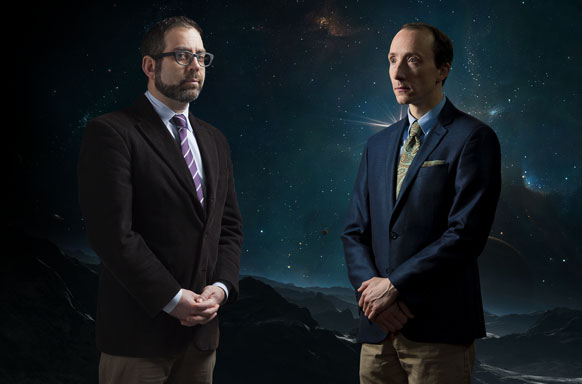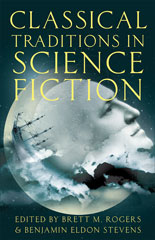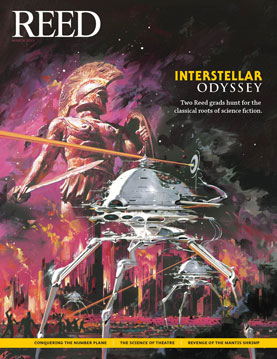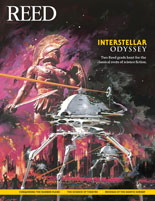
IRIS login | Reed College home Volume 94, No. 1: March 2015
Interstellar Odyssey

Brett Rogers ’99 (left) and Benjamin Stevens ’98 Photos: Rogers by Hayley Young; Stevens by Jeff Fusco
Uncovering the origins of science fiction in the ancient classics
By D.K. Holm
Somewhere in your television viewing past, or buried at the bottom of a dusty shoebox filled with VHS tapes, there may be an old film called The Creation of the Humanoids. Released in 1962, the film chronicles tensions in a postapocalyptic civilization that depends on robots known as “clickers” for slave labor. Like much science fiction, Humanoids appears on the surface to be about one thing—human beings vs. robots—but is really about something else—in this case, racism.
Reacting against robot intrusion into society, an anticlicker Klan arises, led by Capt. Kenneth Cragis (Don Megowan), whose mission is to root out a clicker conspiracy to replace human beings with replica humanoids. In the end, Cragis discovers that he himself has been a clicker all along. As film writer Chris Fujiwara has pointed out, Cragis’ discovery links him with Oedipus, whose hunt for the mysterious child abandoned by Jocasta finally leads him to the horrifying truth that he is the killer of his own father and the husband of his own mother.

Classical Traditons in Science Fiction
Humanoids is hardly an exception. The history of science fiction as literature and film is marbled with astute and story-structuring allusions to the classics, as demonstrated by Classical Traditions in Science Fiction, a groundbreaking anthology which explores the Attic roots of the most modern and future-oriented of literary genres.
Edited by two Reedies, Brett Rogers ’99 and Ben Stevens ’98, the book marries two formerly separate disciplines and shows how classical themes constantly recur in SF, despite the genre’s obsession with new worlds and new technologies.
Published as part of Oxford’s Classical Presences series, the book marshals 14 essays by scholars of the classics, Greek, English, and philosophy with a twofold purpose:
“We think that a wide range of modern SF should be of great interest to anyone already interested in the ancient world and its classics. Moreover, we hope that this volume’s chapters demonstrate the relevance of a wide range of Greek and Roman classics for modern SF. Both as an area in which the meanings of classics are actively transformed, and as an open-ended set of texts whose own classic status is a matter of ongoing discussion and debate, SF stands to reveal much about the roles played by ancient classics as well as new classics in the modern world.”
The essays explore connections between Jules Verne and the Greek satirist Lucian; Dune and the Iliad; Alien Resurrection and the Odyssey; antiquity and Western identity in Battlestar Galactica; the Iliad and Dan Simmons’s Ilium; The Hunger Games and the Roman Empire; and the graphic novel Pax Romana, which explores the transition from antiquity to a Christian world.
The book devotes considerable attention to what William Johnson has called SF’s “territorial vagueness.” It’s easy to say that we know SF when we see it, but a working definition proves surprisingly elusive. As contributor Antony Keen writes, when it comes to science fiction, “there will always be debatable regions at the definitional margins.” He goes on to quote Adam Roberts’ dictum that science fiction is “premised on a material, instrumental version of the cosmos,” in contrast to its close ally, fantasy, which concerns “magic, the supernatural, the spiritual.” Alternately, Susan Sontag summed up the whole genre as consisting of the “imagination of disaster,” a fascination with/dread of irresistible destruction.
Under the aegis of writers such as H.G. Wells, SF fell within the “novel of ideas,” where brainiacs could envision an improved future of flying cars, sensible social orders, and interplanetary journeys. This air of make-believe may be what keeps SF segregated in bookstores and offered as a novelty subject in college curricula rather than accepted as general literature—its imaginativeness aligns the SF field with comic books, cartoons, and lurid pulp magazines (and of course the pulps spawned the careers of several beloved SF writers, including Alfred Bester, Isaac Asimov, Robert Heinlein, and Arthur C. Clarke). To be literature, one school of thought goes, an SF novel must be depressing—an account of hubris and failure, such as George Orwell’s 1984, where Winston Smith gains meager insight into the political forces behind his drab world before being crushed by the state, or in what some consider the first science fiction novel, Mary Shelley’s Frankenstein, where the optimism that drives scientific advance is hobbled by that familiar X factor, the human element.
But Frankenstein, after all, is subtitled The Modern Prometheus—a clue that even in its inchoate state, science fiction was drawing upon Greek concepts and themes. SF was not just pure fantasy, but was rooted in the classic tradition. In the case of Frankenstein, Shelley drew upon the myth of Prometheus, who steals fire from the gods and is condemned to eternal damnation. Dr. Frankenstein is seeking higher human knowledge, the secret to the spark of life, and pays dearly for it.
Jesse Weiner’s essay “Lucretius, Lucian, and Mary Shelley’s Frankenstein” gives a thorough account of the book’s debate with the ancients, its later influence, and Shelley’s ambivalence about scientific progress. Weiner notes that the SF genre is “concerned, not only with the speculative possibilities of science, but also with the ethical boundaries of human knowledge.” He also points out that the doctor’s “project of bringing forth a living creature from dead and decaying material appears to draw its inspiration from Lucretius’s favorite example of spontaneous generation . . . Shelley’s moral rejection of Lucretian science in Frankenstein has been described as a reaction against the Promethean radicalism of her husband, and of her father and mother, William Godwin and Mary Wollstonecraft. Be that as it may, Shelley’s ethical antipathy to Lucretius and the promises of modern science need not refute their epistemological legitimacy.”
Weiner continues:
Shelley’s ambivalent handling of Lucretian material in her novel extends to a motif of gigantomachy, or war among giants. Lucretius famously celebrates the gigantomachy, likening the attempts of various mythological giants to overthrow the Olympian pantheon through force to his own attempt to liberate mankind from superstition through reason and science. Frankenstein has, of course, attempted to usurp the power of God and Nature through science, and the rebellion of Frankenstein’s monster (who is, quite literally, a chthonic giant) forms the novel’s conflict. Rebelling against their creators, Frankenstein and his monster are not merely latter-day Prometheis; they are modern giants. The dialogue of their conflict frames the strife in terms of hierarchical inversion and martial imagery of the thunderbolt, the weapon used by Zeus to defeat Typhon, a giant monster who rose against Olympus. The Frankenstein myth as a gigantomachy is tantalizingly suggested by Percy Shelley, who describes the experience of reading Frankenstein with imagery drawn from the Greek myth of the giants Otos and Ephialtes: “Pelion is heaped on Ossa, Ossa upon Olympus.”
Classical connections come under scrutiny in Rebecca Raphael’s discussion of the links between Blade Runner (and its source, Philip K. Dick’s Do Androids Dream of Electric Sleep?), and the story of Pygmalion and Galatea in Ovid’s Metamorphoses. Pygmalion is a sculptor who carves a statue of a woman in ivory. So beautiful is the statue that Pygmalion falls in love with it, and prays to Venus for a wife just like her. That night, he makes love to the statue, and finds that Venus has granted his wish: Galatea comes alive (although her flesh is described as “waxy”) and later gives birth to a son named Paphos.
Raphael notes that she is not tracing “direct influence, but rather a comparative analysis of two phases of Western civilization’s engagement with the idea of artificial life . . . Blade Runner and Do Androids Dream do not explicitly rework the classical material, but rather continue variations on a theme, working with the structural possibilities implicit in the concept of artificial life in relation to humans.” With both the older myth figures and the characters of Roy Batty and Pris in Blade Runner, “there is a combination of exceptional ability or power and some deficiency or lack, relative to the divine or the human norm.” (Other classical “robots” include the golden maidens of Hephaestus in the Iliad and the bronze warrior Talos in the Argonautica.)
Unlike Dr. Frankenstein, however, Pygmalion “creates only the artifact, not the life”—only Venus has the power to do that. Galatea is ultimately a creature of the gods, and does not represent a threat to the natural order, whereas Frankenstein’s creation is a true “monster” in the classical sense.
![]()


LATEST COMMENTS
steve-jobs-1976 I knew Steve Jobs when he was on the second floor of Quincy. (Fall...
Utnapishtim - 2 weeks ago
Prof. Mason Drukman [political science 1964–70] This is gold, pure gold. God bless, Prof. Drukman.
puredog - 1 month ago
virginia-davis-1965 Such a good friend & compatriot in the day of Satyricon...
czarchasm - 4 months ago
John Peara Baba 1990 John died of a broken heart from losing his mom and then his...
kodachrome - 7 months ago
Carol Sawyer 1962 Who wrote this obit? I'm writing something about Carol Sawyer...
MsLaurie Pepper - 8 months ago
William W. Wissman MAT 1969 ...and THREE sisters. Sabra, the oldest, Mary, the middle, and...
riclf - 10 months ago